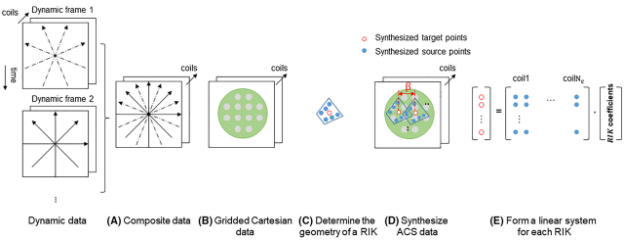Non-Cartesian k-space reconstruction to improve acquisition efficiency
A non‐Cartesian k‐space reconstruction method using self-calibrated, region‐specific interpolation kernels for highly accelerated acquisitions in MRI.

Applications
- MRI parallel imaging
- Non-Cartesian imaging
- 3D imaging
- 4D high-resolution imaging using kooshball acquisition
Key Benefits & Differentiators
- Eliminates lengthy reference scans or long reconstruction times
- Determines interpolation kernels based on the data itself rather than requiring an additional reference scan
- Highly accelerated reconstruction with comparable image quality to TT-GRAPPA (currently available non-Cartesian) technique; 3-5 times faster than CG-SENSE technique
- Provides increased temporal resolution without loss of spatial resolution
- Ideal for free-breathing scanning as there is no calibration steps
Overview
In MRI scanning, parallel imaging techniques such as GRAPPA use properties of multicoil receiver arrays to recover missing k‐space data points using nearby acquired k‐space samples. In conventional non‐Cartesian GRAPPA with through‐time GRAPPA (TT‐GRAPPA), the use of region‐specific interpolation kernels has demonstrated improved reconstruction quality in dynamic imaging for highly accelerated acquisitions. However, TT‐GRAPPA requires the acquisition of a large number of separate calibration scans, which lengthens overall scan duration; for every ~20 s data acquired, there is a ~3 min calibration data acquisition step.
To eliminate calibration steps and reduce overall scan time, researchers at the University of Minnesota have developed a new reconstruction method named Self‐calibrated Interpolation of Non‐Cartesian data with GRAPPA (SING) to self‐calibrate region-specific interpolation kernels from dynamic undersampled measurements. The SING method synthesizes calibration data to adapt to the distinct shape of each region-specific interpolation kernel geometry, and uses a novel local k‐space regularization through an extension of TT‐GRAPPA. This calibration approach is used to reconstruct non‐Cartesian images at high acceleration rates while mitigating noise amplification. Researchers have shown that SING offers visually and quantitatively similar reconstruction quality to TT‐GRAPPA, and provides improved reconstruction quality over conjugate‐gradient SENSE in both numerical phantom and in vivo cine data sets. In the SING method, the computational burden is spent up-front and is low for subsequent data; and can be highly parallelized for rapid application such as for free-breathing scans.Phase of Development
Demonstrated in a 3T clinical field strength scanner for cardiac imaging with radial acquisition.Desired Partnerships
This technology is now available for:- License
- Sponsored research
- Co-development
Please contact our office to share your business’ needs and learn more.
Researchers
- Mehmet Akcakaya, PhD, Associate Professor, Electrical and Computer Engineering, CMRR
- Steen Moeller, PhD, Assistant Professor, CMRR
-
expand_more library_books References (1)
- Chieh, Seng‐Wei, Mostafa Kaveh, Mehmet Akçakaya, and Steen Moeller. , Self‐calibrated interpolation of non‐Cartesian data with GRAPPA in parallel imaging., Magnetic resonance in medicine 83, no. 5 (2020): 1837-1850.
-
expand_more cloud_download Supporting documents (1)Product brochureNon-Cartesian k-space reconstruction to improve acquisition efficiency.pdf